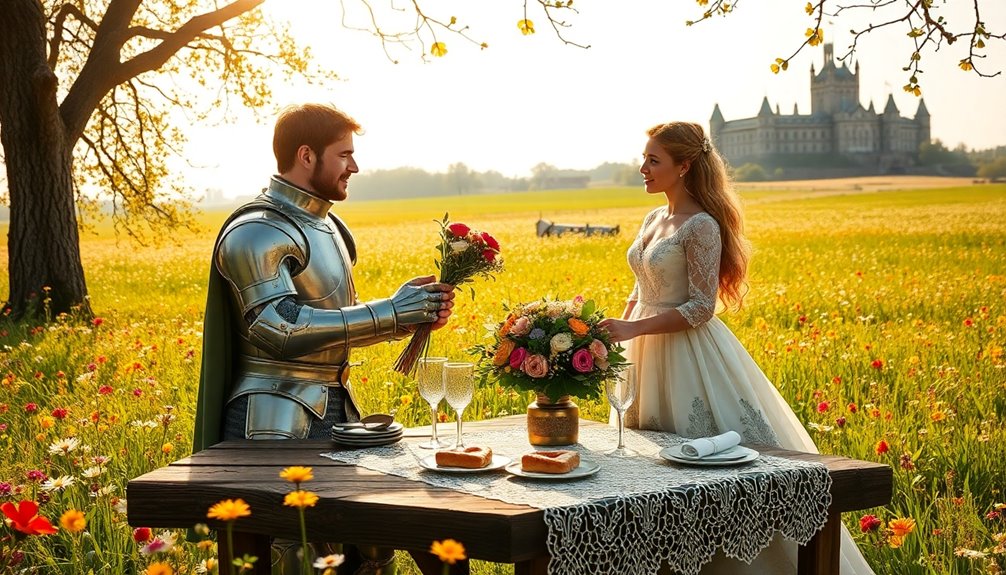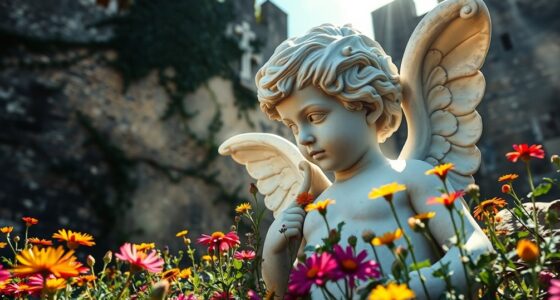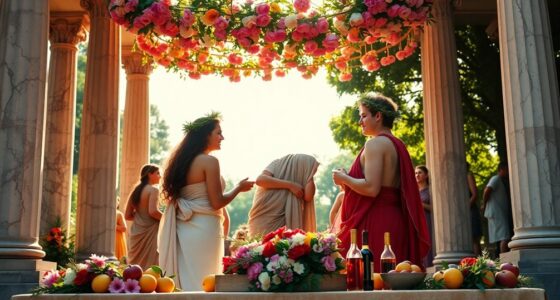Valentine's Day in the Middle Ages was a lively celebration of love, marked by courtly traditions and romantic expressions. It became closely associated with the feast day of St. Valentine, who defied marriage bans out of love. You'll find that literature played a vital role, with poets like Chaucer intertwining romance and nature. Ordinary people also participated in public courtship rituals, showcasing their affections openly. There's so much more to uncover about this fascinating time!
Key Takeaways
- Valentine's Day in the Middle Ages celebrated courtly love, intertwining social class with elaborate courtship rituals and poetic expressions of affection.
- Geoffrey Chaucer famously linked Valentine's Day to romantic love in his poem "Parliament of Fowls," associating it with bird mating rituals.
- Commoners actively participated in Valentine's celebrations, with public courtship and documented marriage intentions reflecting the day's cultural significance.
- Exchanging tokens of love, such as rings and love letters, became popular practices symbolizing devotion among couples during this period.
- The transition from personal notes to mass-produced Valentine cards began in the 19th century, evolving from medieval customs into modern celebrations.
The Origins of Valentine's Day
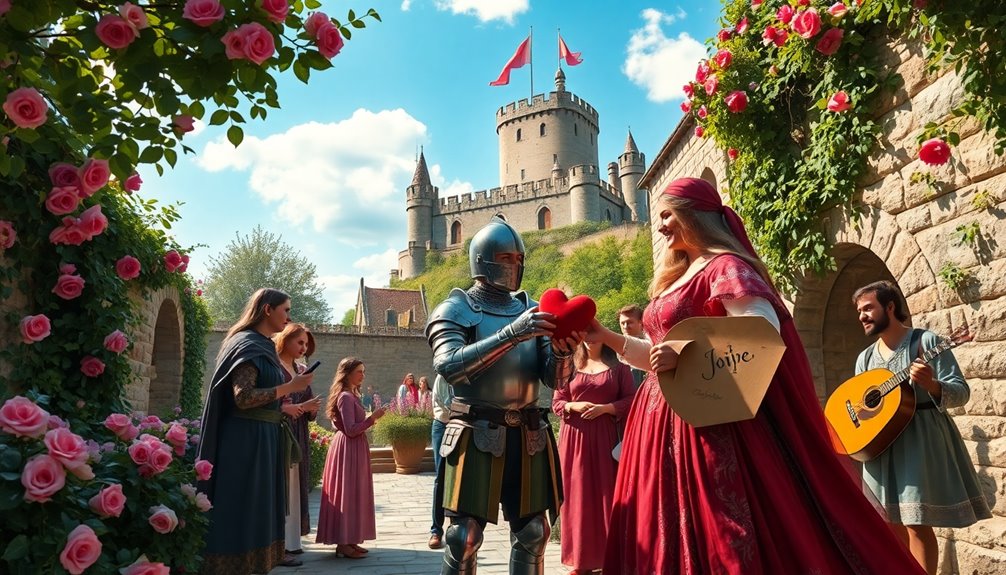
Although many people associate Valentine's Day with flowers and chocolates, its origins are rooted in ancient traditions. Celebrated on February 14, this day links back to the Feast of Lupercalia, an ancient Roman festival that celebrated fertility and love.
Initially, Saint Valentine's Day drew from two early Christian martyrs, with no romantic connotations in their stories. It wasn't until the medieval origins of Valentines that the day began to take on its romantic hue.
Geoffrey Chaucer popularized the idea of February 14 as a day for lovers in his poem "Parliament of Fowls," where he described birds selecting their mates. This transformation of Valentine's Day significance marked a significant shift in how love and courtship were celebrated during the Middle Ages.
The Influence of St. Valentine
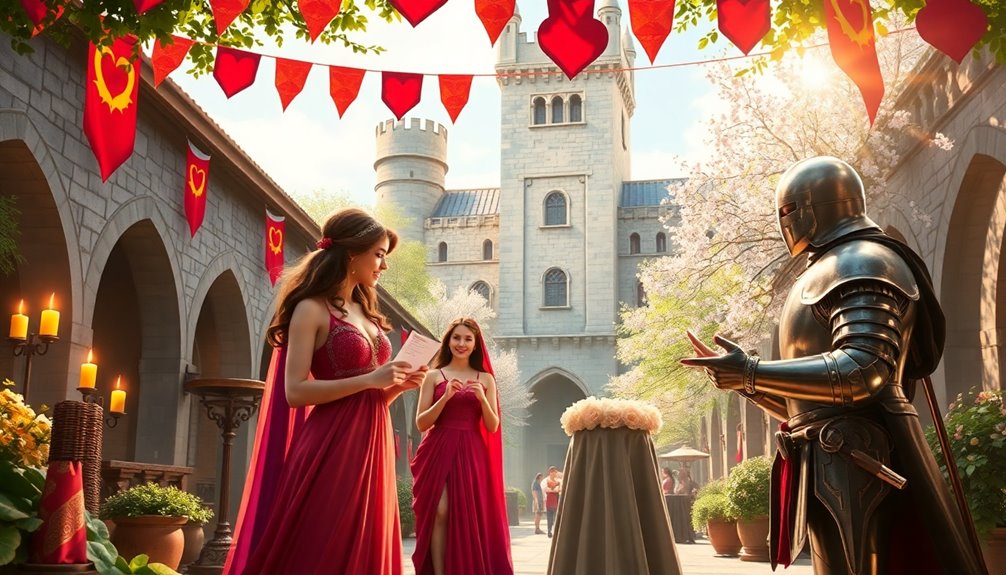
When you think about St. Valentine, you might picture the stories of his martyrdom and the legends that surround him.
These tales not only shaped his legacy but also influenced how romantic customs evolved over time.
As you explore the impact of St. Valentine, you'll see how his actions sparked a celebration of love that resonates even today.
Legends of St. Valentine
Legends of St. Valentine shape the essence of romantic love today. He's remembered for defying Emperor Claudius II's ban on engagements, secretly marrying couples in love. This act of bravery links him to the celebration of love.
Key elements of his legacy include:
- The phrase "From your Valentine," a heartfelt note to the jailer's daughter he cured.
- The ancient Feast of Lupercalia, which inspired the romantic customs of Valentine's Day.
- Geoffrey Chaucer's "Parliament of Fowls," connecting the day with birds choosing their mates.
These legends of St. Valentine transformed February 14 into a day where love flourished, making it a cherished occasion for couples throughout the ages.
St. Valentine's Martyrdom
St. Valentine, a Roman priest, faced martyrdom around 269 AD for defying Emperor Claudius II's marriage ban. He believed that allowing couples to wed would create happier soldiers.
His execution on February 14 marked a pivotal moment, as this date gradually became linked to love and romance through his enduring legend.
One story tells how he restored the sight of his jailer's blind daughter while imprisoned, creating a romantic bond that further cemented his legacy.
Before his execution, St. Valentine reportedly signed a letter to her with the phrase "From your Valentine," which remains popular today.
Canonized by the Catholic Church, his martyrdom established St. Valentine as the patron saint of lovers, influencing the traditions we celebrate on Valentine's Day.
Impact on Romantic Customs
As the legend of St. Valentine grew, so did the impact on romantic customs during the Middle Ages.
By the 14th and 15th centuries, Valentine's Day became a celebration of love.
Here are three ways it influenced romantic gestures:
- Literary Inspiration: Geoffrey Chaucer linked Valentine's Day with birds choosing their mates, creating a poetic backdrop for love.
- Love Notes: The first Valentine card, written by Charles, Duke of Orleans, marked the beginning of exchanging heartfelt notes.
- Courtly Love: Practices of courtly love fostered the sharing of poetic verses and gifts, solidifying the day's significance.
These customs and stories transformed Valentine's Day into a cherished occasion for expressing love that continues today.
Courtly Love and Romance in the Middle Ages
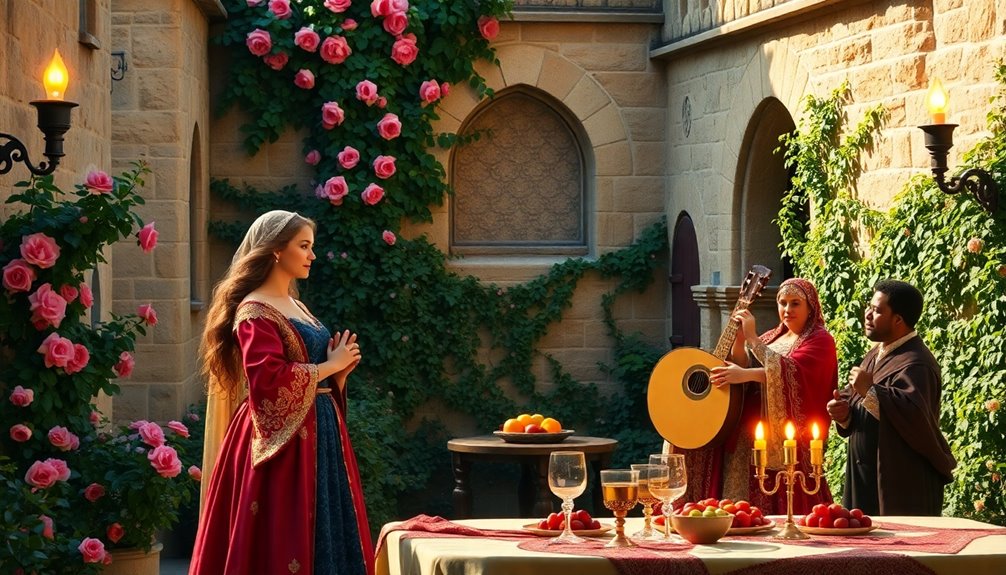
In the Middle Ages, courtly love transformed how you experienced romance, intertwining social class with elaborate courtship rituals.
You'd find yourself enchanted by the poetic expressions and secret admirations celebrated in literature, which often depicted love as a noble pursuit.
This intricate dance of devotion and desire not only shaped personal relationships but also laid the groundwork for the romantic customs we cherish today on Valentine's Day.
Courtship Rituals and Practices
While courtly love in the Middle Ages often seemed unattainable, it was defined by intricate courtship rituals that allowed knights and ladies to express their affections.
These rituals included:
- Exchanging Tokens: Knights often gifted tokens, like rings or personalized items, to symbolize their devotion.
- Writing Love Letters: The art of love letters flourished, with Margery Brews' 1477 letter famously addressing her cousin as "my right well beloved Valentine."
- Poetic Expressions: Geoffrey Chaucer captured the essence of these rituals in his poem "Parliament of Fowls," where birds choose their mates on St. Valentine's Day, linking the day to romance.
These practices not only emphasized chivalric ideals but also revealed the complexities of relationships during this enchanting era. Furthermore, the emotional nuances of courtly love can parallel the intricacies of supporting children through divorce, highlighting how relationships can be both beautiful and challenging.
Literary Influences on Romance
Courtly love, with its noble ideals and romantic devotion, profoundly influenced medieval literature, shaping how society viewed love and relationships. Geoffrey Chaucer, a prominent figure of this era, captured these themes in works like "Parliament of Fowls," linking Valentine's Day to the romantic selection of mates among birds. This connection elevated February 14 as a day of love. The emergence of written expressions of affection, as seen in Margery Brews' 1477 Valentine letter, also marked a shift in romantic communication.
| Theme | Example | Significance |
|---|---|---|
| Unrequited Love | "The Book of the Duchess" | Highlights longing and desire |
| Chivalry | "Sir Gawain and the Green Knight" | Exemplifies noble conduct in love |
| Romantic Devotion | "Troilus and Criseyde" | Explores the complexities of love |
| Written Affection | Margery Brews' letter | Introduces personal romance letters |
| Valentine's Day | Chaucer's poem | Establishes a day for love |
Social Class and Love
The ideals of courtly love shaped not just literature, but also the intricate social dynamics of the Middle Ages. While aristocrats engaged in lofty romantic pursuits, the reality of love varied across social classes.
Here's how courtly love influenced relationships during this time:
- Noble Knights: They often adored married or unattainable ladies, showcasing their devotion through valorous acts.
- Non-Elite Romance: Lower classes prioritized affection over social status, seeking mates on St. Valentine's Day based on mutual feelings.
- Romantic Rituals: Secret meetings and love letters revealed the emotional complexities of relationships, emphasizing both joy and strife.
Courtly love may have painted an idealized picture, but the true nature of romance was diverse, reflecting both blissful unions and troubled marriages.
Birds and the Mating Season
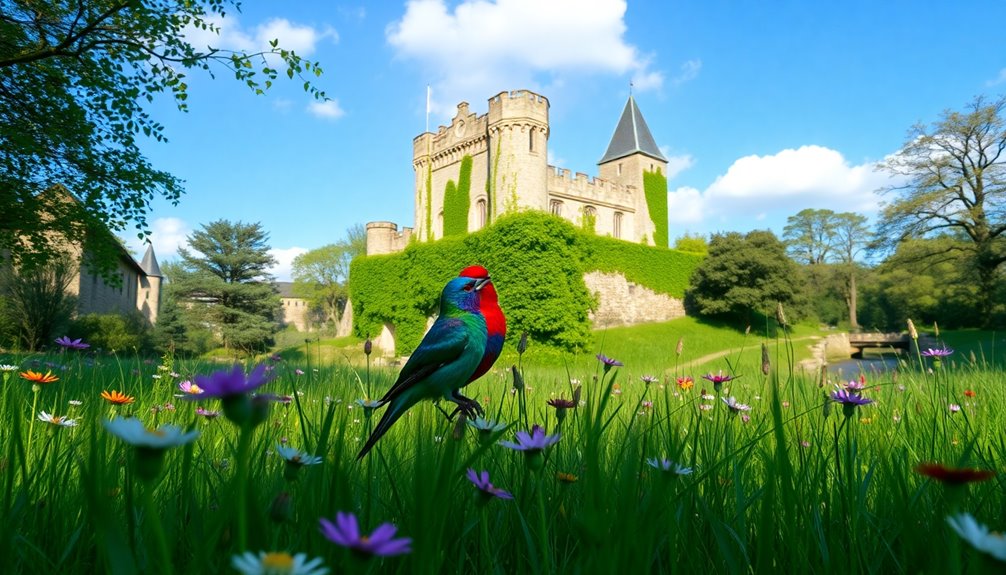
As February 14 approaches, many might not realize that this date has long been associated with the awakening of nature, particularly the mating rituals of birds. In medieval Europe, it was believed that birds began their mating season on this feast day, symbolizing renewal and romance. Poets like Geoffrey Chaucer popularized this connection, describing how birds gathered to choose their mates.
Here's a quick visual representation of these ideas:
| Aspect | Details |
|---|---|
| Date | February 14 |
| Associated With | Mating season of birds |
| Cultural Impact | Inspired courtship traditions |
| Poetic Reference | Chaucer's "Parliament of Fowls" |
These avian behaviors shaped romantic expressions in France and England, marking a significant cultural moment.
The First Valentine's Day Card
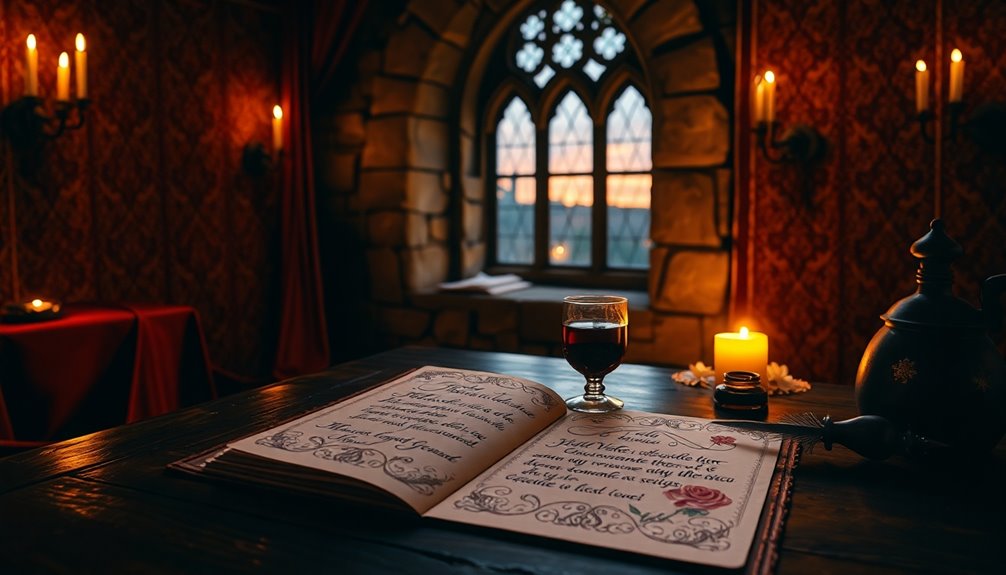
The first Valentine's Day card was penned in 1415 by Charles, Duke of Orleans, while he was imprisoned in the Tower of London. Addressed to his wife, this heartfelt note is now preserved at the British Library.
The evolution of this tradition includes:
- The phrase "From your Valentine," linked to Saint Valentine of Rome.
- A shift from personal notes to mass-produced cards in the 19th century.
- The influence of rulers like Richard II, who promoted romantic expressions.
These early cards laid the foundation for the Valentine's Day celebrations we cherish today. Historically, the celebration also included emotional well-being as a focus, reflecting the significance of relationships during the Middle Ages.
Valentine's Day Celebrations Among Ordinary People
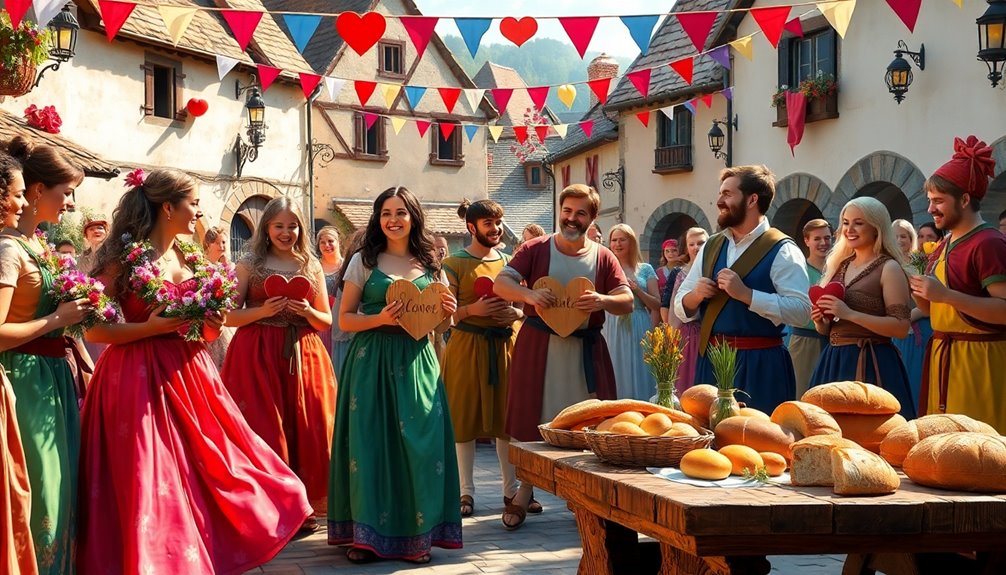
Although often associated with the nobility, Valentine's Day celebrations were vibrant among ordinary people in the Middle Ages. Courtship rituals flourished, with many expressing their affections on this special day.
For instance, in 1486, John Wells publicly courted Alice Billingham, declaring his intentions to marry her. Their betrothal was celebrated with a toast, showcasing how love was a communal affair. Ordinary people participated actively in these traditions, reflecting the cultural significance of romantic relationships.
Court records reveal that many documented their intentions to marry, highlighting that Valentine's Day wasn't just for the elite. These celebrations among commoners illustrate a broader acceptance of love and courtship, making Valentine's Day a cherished occasion for all.
Literary References to Valentine's Day
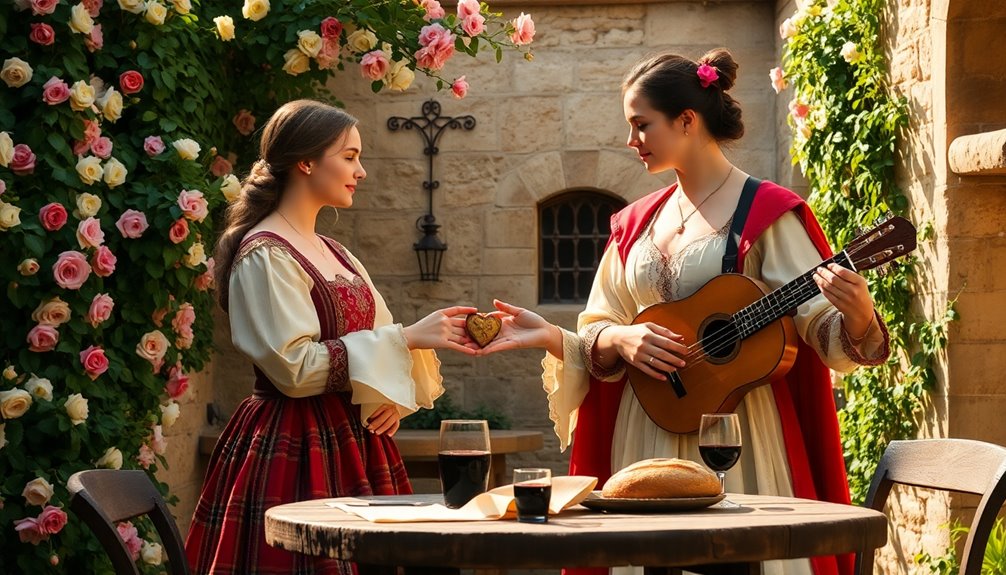
The lively celebrations of Valentine's Day among ordinary people laid the groundwork for literary explorations of love and courtship. Poets like Geoffrey Chaucer began to weave romantic rhetoric into their works, highlighting the day's significance.
Notable literary references include:
- Chaucer's "Parliament of Fowls" – This poem connects Valentine's Day to romance as birds select their mates on "seynt valentynes day."
- Margery Brews' Valentine letter (1477) – Addressing her cousin as "my right well beloved Valentine," she marks a shift in personal love expressions.
- John Lydgate's poem – His work reflects the intertwining of courtly love and religious devotion, further enriching Valentine's literary tradition.
These contributions established a rich tapestry of love that continues to resonate today.
The Evolution of Valentine's Traditions

As Valentine's Day evolved, it transformed from simple medieval customs of exchanging love notes into a vibrant celebration rich with traditions.
Initially inspired by the martyrdom of Valentine of Terni, who the Catholic Church recognized for his acts of love, the day gained significance over the centuries.
By the 1720s, lovers began crafting verses and handmade cards adorned with romantic symbols like Cupids and hearts.
The introduction of commercial valentines around 1800 marked a shift, leading to mechanical valentines by 1840.
As the 20th century rolled in, sending valentines became increasingly popular, with milestones like 20,000 cards sent from the Hammond post office in 1929, solidifying its status as a major holiday for greeting card sales in the U.S.
Cultural Significance of Valentine's Day
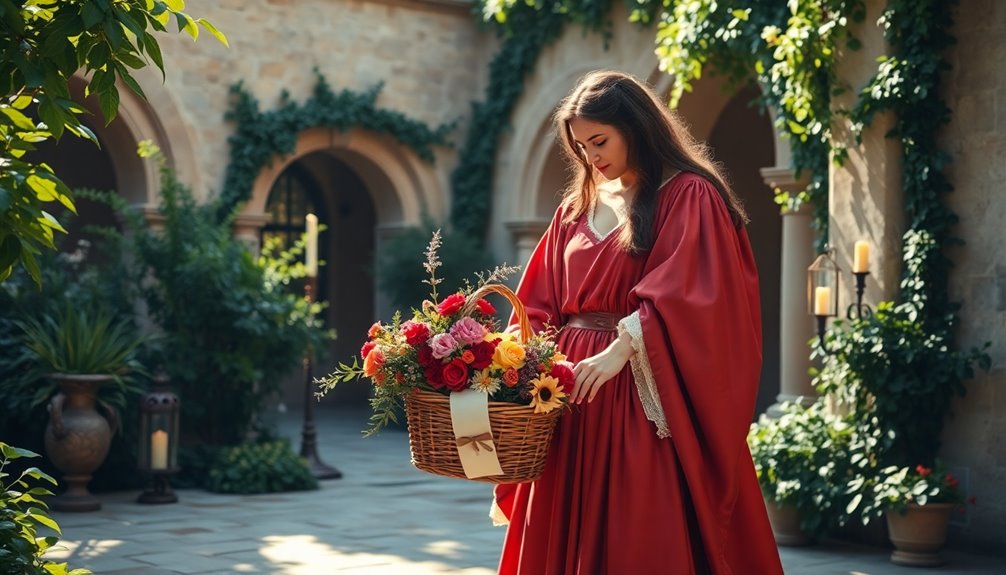
Valentine's Day isn't just a date on the calendar; it's a celebration steeped in cultural significance that reflects humanity's enduring desire for connection.
Originating from early medieval customs, Seynt Valentynes day became a symbol of courtly love, influencing how we express affection today.
Here are three key aspects of its cultural impact:
- Literary Influence: Geoffrey Chaucer's writings linked the day to birds choosing their mates, highlighting love's natural bond.
- Love Tokens: Exchanging notes and gifts on Valentine's Day became popular, allowing people to articulate their feelings.
- Widespread Acceptance: By the 14th century, the celebration transcended aristocratic circles, showing that love and courtship were part of everyday life for everyone.
Frequently Asked Questions
How Was Valentine's Day Celebrated in the Middle Ages?
Valentine's Day in the Middle Ages was all about expressing love and affection. You'd write heartfelt verses or notes to the person you admired, often filled with courtly love themes.
Young men would participate in social gatherings, exchanging tokens of affection while showcasing their chivalry. The day became a celebration of romance, with couples engaging in rituals that emphasized emotional connections, making it a special occasion for budding relationships and heartfelt expressions.
What Was Romance Like in Medieval Times?
Imagine a world where love's expression is cloaked in formality and honor. In medieval times, romance isn't about fiery passion; it's about chivalry and admiration.
You'd see knights penning poetry and performing noble deeds to win the hearts of ladies, often without the promise of physical closeness. Courtship rituals, filled with letters and gifts, set the stage for love, but societal norms dictate that many remain single, waiting for a connection that may never come.
What Is the Romantic History of Valentine's Day?
Valentine's Day has a rich romantic history rooted in the 14th century, where poets like Geoffrey Chaucer celebrated love in their works.
You'll find that the day's association with affection grew with the exchange of love notes and tokens, marking February 14 as a time for expressing deep feelings.
This tradition evolved from ancient festivals, transforming Valentine's Day into a cherished occasion for couples to celebrate their love and connection through heartfelt gestures.
What Is the Pagan Equivalent of Valentine's Day?
You might find it fascinating that Lupercalia, the ancient Roman festival, is often seen as the pagan equivalent of Valentine's Day.
Celebrated in mid-February, it involved rituals promoting fertility and love, where young men paired with women for the festival's duration.
Picture the excitement of name-drawing, and the playful yet provocative traditions that symbolized renewal and connection.
It's intriguing how these ancient customs laid the groundwork for our modern celebrations of love.
Conclusion
As you reflect on Valentine's Day, think of it as a blossoming rose, rich with history and layered meanings. Its roots entwine with the stories of St. Valentine and the whispers of courtly love, reminding us that affection has always been cherished. Just as birds herald the arrival of spring, your own expressions of love can breathe life into relationships. Embrace these traditions, for they symbolize not just romance, but the enduring connection between hearts throughout the ages.
